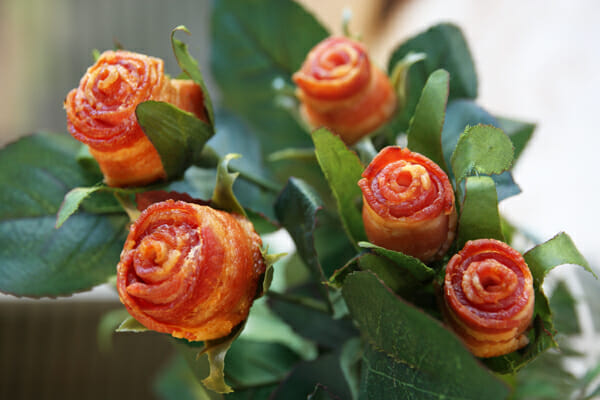Image from Charlotte's Fancy.
Make your own iDad card with this tutorial!
Image from mylastbite.com
Or how about a bouquet of BACON roses?!?!?! There are several tutorials for this craft. To make the roses above click here.
Image from ourbestbites.com
This bacon bouquet is a little more involved, but super cute and YUMMY! Perfect for the pork loving father in your life. Click here for the tutorial
Image from Pinterest.
Here's a cute card to make from the children! I snagged the photo from pinterest. It seems that the one minute craft website is down, otherwise I would like to it directly. I think I can actually get all of my kids shoes on this size I have such variety in ages.
image from Pinterest.
And, being a homeschool parent, there is a certain joy in turning ALL things into an educational experience. So download this free project and get those kids writing about Super Dad!
And of course, Pinterest is the source of all things craftsy so click here to see a sampling of Father's Day crafts and ideas.
Happy Father's Day crafting!
Mrs. P
Tuesday, June 12, 2012
Monday, June 4, 2012
How to learn those pesky math facts.
Drill, Drill, Drill.
Ok.
End of story.
No really, that is the best way to learn them. And if you are like me, then this isn't such good news. I couldn't keep up with a stack of math flash cards if my life depended on it! I mean, my toddler thinks it is great fun to see the math facts "rain" down on the bottom floor from our school loft. Imagine hundreds of math facts and/or Latin flash cards raining down. Not that I've actually witnessed this...at least I'm not admitting it. So although, in theory, flash cards should be do-able. And, in theory, it shouldn't be hard. Somehow it IS hard to keep up the drill work involved in memorizing math facts. So let me just say that when I heard about and used www.xtramath.com on the internet I sang praises! I danced in the moonlight without coercion from flying insect! I signed all of my kids up and set them straight to work on drill work. And then I threw away the random and stray math flash cards that survived the rain. And then I ate chocolate, because all celebrations should include chocolate.
Ok.
End of story.
No really, that is the best way to learn them. And if you are like me, then this isn't such good news. I couldn't keep up with a stack of math flash cards if my life depended on it! I mean, my toddler thinks it is great fun to see the math facts "rain" down on the bottom floor from our school loft. Imagine hundreds of math facts and/or Latin flash cards raining down. Not that I've actually witnessed this...at least I'm not admitting it. So although, in theory, flash cards should be do-able. And, in theory, it shouldn't be hard. Somehow it IS hard to keep up the drill work involved in memorizing math facts. So let me just say that when I heard about and used www.xtramath.com on the internet I sang praises! I danced in the moonlight without coercion from flying insect! I signed all of my kids up and set them straight to work on drill work. And then I threw away the random and stray math flash cards that survived the rain. And then I ate chocolate, because all celebrations should include chocolate.
10 Great things about XtraMath:
- It's FREE
- It's EASY
- I don't have to keep up with which kid knows the 2's, 5's and 10's and which kid needs to practice their 4's! This is HUGE!!!
- It's on the computer so I can't lose it!
- No papers to keep up with or print out!
- No more index cards all over my house!
- The kids don't even hate it!
- It only takes 5 minutes a day!
- You can see progress on a special "teacher" page.
- You can play several times a day, if needed.
Saturday, June 2, 2012
Cheese Making for the Beginner
At the farm these days, my milk pail overflows. So I spent some time this week making some cheese. It’s a good way to preserve the excess milk. I also freeze extra (goat) milk and I have a recipe for canning milk. However, I have not canned milk. yet. It’s likely that I’ll can some milk one of these days. Oh…that reminds me that I have a recipe for sweetened condensed milk. Yes, that may be my next canning project. OK..back to the matter at hand, cheese.
Cheese is a rather simple way to preserve your milk for a little bit. So when the milk pail overflows at your house, try this recipe. It is easy, requires very few ingredients, and your friends will think your are an artisan cheese maker when they have a bite. The best part is you don't even have to milk an animal. Just grab some whole milk from your local supermarket.
You take little balls of this delectable cheese and layer them in a jar with herbs and seasoning. Then you pour olive oil over it all. The olive oil helps preserve the cheese and seals out air. The flavor is amazing, especially if you are patient enough to wait a week or so to let the flavors meld together. So here’s your supply list.
Labaneh (a yogurt cream cheese)
You will need:
1 gallon of milk ( can be any kind, store bought, fresh, skim, whole)
1/2 c. cultured yogurt (like Brown Cow or Dannon, plain, unflavored)
fresh basil leaves
sundried tomatoes
fresh cloves of garlic
olive oil
pint jar
butter muslin (or a square of fine weave fabric like batiste or muslin)
colander
gallon glass jar
heating pad
cooler
How to make Yogurt:
Add 1/2 c. of yogurt to your glass jar. Heat your milk to between 110-114 degrees. Stir milk into yogurt. Incubate for 6-8 hours at 90-110 degrees. To keep this temp, put your gallon jar in a cooler with a heating pad set on low. Or do as I do and use fresh, strained milk straight from the barn. It's the perfect temperature. Then I incubate it in my Excalibur dehydrator. It makes perfect yogurt every time. After the yogurt is thickened, chill in the fridge overnight. It will thicken more in the fridge. If you are using goat’s milk, you may want to add 1/2 c. of dry milk to the milk and yogurt when you are starting out. This will thicken it slightly. As a general rule, goat milk doesn’t thicken like store bought yogurt. If you want to cheat, then just buy the biggest containers of plain yogurt you can find (to equal 1 gallon of yogurt) at the supermarket and proceed as follows.
How to make the Lebanah:
Strain the yogurt in a cheesecloth for several hours. The easiest way to do this is to line your colander with cheesecloth. It will need a very fine weave and usually is sold as "butter muslin" rather than cheese cloth. To sterilize the cloth, iron with a hot iron. When the yogurt is poured into the muslin in the colander, tie the four corners together. You can then hang it on a cabinet door or hook with a bowl underneath to catch the whey as it drips.
Once the yogurt has been strained, scoop little balls of the yogurt cheese with a spoon or cookie scoop. Put them in a quart mason jar. As you add little balls of cheese add in layers of herbs and spices as desired. A nice combination is fresh basil, sun dried tomatoes, peppercorns, and garlic cloves. When the jar is full, pour olive oil over the top. Let this sit in the fridge several days to a week for the herbs to season the cheese. To eat, serve the little cheese balls on a plate with crackers or veggies.
I learned to make this cheese in a Cheese Making class at Homestead Heritage. You can see the lebanah in the photo above taken from the cover of the How to Make Soft Cheese book published at Homestead Heritage. Here is a link for more information on the class that I took. It was worth every penny.
http://www.homesteadheritage-homesteading.com/soft_cheese.html
Blessings,
Mrs. P
Subscribe to:
Posts (Atom)






